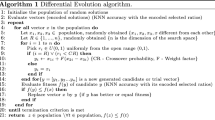Abstract
Corporate bankruptcy prediction has seen impressive research over the last couple of decades, mainly because of its immense importance in credit-risk management. Researchers from academia and industry have nearly exhausted the machine learning space to find the most accurate model for bankruptcy prediction. All of these researches have achieved great yet heterogeneous results. We attempt to extend this research and thereby suggest a homogeneous approach for the bankruptcy prediction problem using evolutionary methods—genetic algorithm (GA) and particle swarm optimization (PSO). We use GA for feature selection and PSO for optimizing the weights and biases in a neural network architecture. The feed-forward neural network is then used for prediction. The novelty of our approach lies in its adaptability and generality. The approach can give promising results for different types of data—from different countries or industrial sectors.
Access this chapter
Tax calculation will be finalised at checkout
Purchases are for personal use only
Similar content being viewed by others
References
Altman EI, Financial ratios, discriminant analysis and the prediction of corporate bankruptcy
Aziz A, Emanuel DC, Lawson GH (1988) Bankruptcy prediction an investigation of cash flow based models. J Manage Stud 25(5):419–437
Back B, Laitinen T, Sere K (1996) Neural networks and genetic algorithms for bankruptcy predictions. Expert Syst Appl 11(4):407–413
Chen H-L et al (2011) An adaptive fuzzy k-nearest neighbor method based on parallel particle swarm optimization for bankruptcy prediction. In: Pacific-Asia conference on knowledge discovery and data mining. Springer, Berlin
de Almeida BSG, Leite VC (2019) Particle swarm optimization: a powerful technique for solving engineering problems. In: Swarm intelligence-recent advances, new perspectives and applications. IntechOpen
Demyanyk Y, Hasan I (2010) Financial crises and bank failures: a review of prediction methods. Omega 38(5):315–324
du Jardin P (2009) Bankruptcy prediction models: how to choose the most relevant variables?, pp 39-46
Eberhart R, Kennedy J (1995) Particle swarm optimization. In: Proceedings of the IEEE international conference on neural networks, vol 4. Citeseer
He Y, Ma WJ, Zhang JP (2016) The parameters selection of pso algorithm influencing on performance of fault diagnosis. In: MATEC Web of conferences, vol 63. EDP Sciences
Kumar PK, Ravi V (2007) Bankruptcy prediction in banks and firms via statistical and intelligent techniques-A review. Eur J Oper Res 180.1:1–28
Miranda L (2018) PySwarms: a research toolkit for particle swarm optimization in Python. J Open Sour Softw 3(21):433
Nagaraj K, Sridhar A (2015) A predictive system for detection of bankruptcy using machine learning techniques. arXiv preprint arXiv:1502.03601
Rao NV, Atmanathan G, Shankar M, Ramesh S (2013) Analysis of bankruptcy prediction models and their effectiveness: An Indian perspective. Gt. Lakes Her 7(2)
Verikas A et al (2010) Hybrid and ensemble-based soft computing techniques in bankruptcy prediction: a survey. Soft Comput 14.9:995–1010
Xu Y et al (2017) Computing adaptive feature weights with PSO to improve Android malware detection. Secur Commun Netw
Yao X (1999) Evolving artificial neural networks. Proc IEEE 87(9):1423–1447
Author information
Authors and Affiliations
Corresponding author
Editor information
Editors and Affiliations
Rights and permissions
Copyright information
© 2021 The Author(s), under exclusive license to Springer Nature Singapore Pte Ltd.
About this paper
Cite this paper
Mahendru, K., Garg, G., Sharma, A., Srivastava, R. (2021). Evolutionary Methods for Bankruptcy Prediction: A Study on Indian Firms. In: Tiwari, A., Ahuja, K., Yadav, A., Bansal, J.C., Deep, K., Nagar, A.K. (eds) Soft Computing for Problem Solving. Advances in Intelligent Systems and Computing, vol 1392 . Springer, Singapore. https://doi.org/10.1007/978-981-16-2709-5_23
Download citation
DOI: https://doi.org/10.1007/978-981-16-2709-5_23
Published:
Publisher Name: Springer, Singapore
Print ISBN: 978-981-16-2708-8
Online ISBN: 978-981-16-2709-5
eBook Packages: Intelligent Technologies and RoboticsIntelligent Technologies and Robotics (R0)




